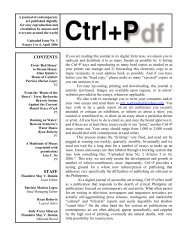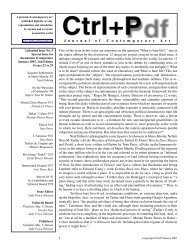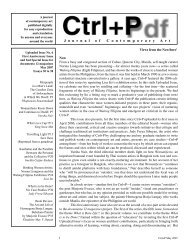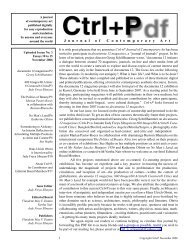Issue 15 - Pdf Ctrl+P - CTRL+P: a journal of contemporary art
Issue 15 - Pdf Ctrl+P - CTRL+P: a journal of contemporary art
Issue 15 - Pdf Ctrl+P - CTRL+P: a journal of contemporary art
Create successful ePaper yourself
Turn your PDF publications into a flip-book with our unique Google optimized e-Paper software.
why they create the way they do,” on the one hand, and to advance the central aesthetic<br />
thesis that “ours is an <strong>art</strong> <strong>of</strong> objectifying visual pleasure,” 23 on the other. The walls were<br />
painted peach, alluding to the “physicalization <strong>of</strong> pleasure”: the exhibitionary and the<br />
<strong>art</strong>istic merge. The critic Cid Reyes was able to propose categories <strong>of</strong> analysis for this<br />
p<strong>art</strong>icular pursuit <strong>of</strong> a Filipino aesthetic in painting: frontality <strong>of</strong> image; fragmentation:<br />
openness <strong>of</strong> forms; décor: enhancements <strong>of</strong> the picture plane; horror vacui: appropriation<br />
<strong>of</strong> space; ‘focal point’: leading the eye to pasture; recession: shallow space; and color:<br />
radiation <strong>of</strong> energy.” 24<br />
This was the second and may have been the last serious attempt <strong>of</strong> the CCP to<br />
strive for discursive density in relation to its collection. The first one was done in 1980<br />
with the exhibition curated by the critic and printmaker Rodolfo Paras Perez titled Five<br />
Directions; it attempted to map out “for meditation the various permutations, perplexities,<br />
the five identifiable tendencies, the ambitions deemed characteristic <strong>of</strong> Philippine<br />
<strong>art</strong>” 25 : non-objectivist, macro-visionist, magic realist, Laguna lake shore, conceptualist.<br />
Curiously missing was the social realist aesthetic that had already potently posited its<br />
agenda since 1971, finding its impetus with the founding <strong>of</strong> Kaisahan in 1976. Surely,<br />
the omission was obvious: the MOPA might not have wanted to present <strong>art</strong> that tried to<br />
disclose an abject social condition, a far cry from Imelda’s idealized City <strong>of</strong> Man, for<br />
which the government was responsible. This policing was, therefore, political, something<br />
that might have also permeated the choices for the Thirteen Artists. As social realist<br />
Renato Habulan would reflect on his belated conferment in 1990 along with confreres<br />
Pablo Baens Santos, Edgar Talusan Fernandez, Antipas Delotavo, and Neil Doloricon:<br />
“Our selection was a vindication <strong>of</strong> work that was deserving but could not be displayed<br />
because <strong>of</strong> the dissenting political implication they held during the Marcos era. We<br />
may have even deserved nomination in the 1970s, but this could not happen under the<br />
(Marcos)administration.” 26 This umbrage is not as simple as it looks, because on the<br />
other hand, the modernist canon makers in New York like Museum <strong>of</strong> Modern Art’s<br />
Alfred Barr during the Cold War would juxtapose the freedom <strong>of</strong> abstract expressionism<br />
with the fascism <strong>of</strong> socialist realism.<br />
Marian Pastor Roces reviewed Five Directions and thought it iterative and recursive:<br />
it “moves into itself and around and over again, in a steady, non-corrective, immutable,<br />
static, state.” 27 While viewed as curatorially faulty, this exhibition, along with The Sensuous<br />
Eye, constitutes the only consolidated effort <strong>of</strong> the Center to assess its collection,<br />
coextensively and implicitly with its exhibitions, in relation to both aesthetics and <strong>art</strong><br />
history. From this stock taking, we could infer <strong>art</strong>istic leanings in terms <strong>of</strong> themes, forms,<br />
and ideas, on the one hand, and a deeper structure <strong>of</strong> an aesthetic sensibility that is constantly<br />
eluded by its grail that is the Filipino, on the other.<br />
NOW: Simula Pa Lamang<br />
The turn away from neorealism towards the <strong>contemporary</strong> may have been heralded<br />
by Raymundo Albano at the Center, who insisted on working on the now, its labor as<br />
the advent <strong>of</strong> an alternative universe that was present—and that was only the beginning.<br />
Albano widened the parameters <strong>of</strong> <strong>art</strong> and invested the modern not only with the notion<br />
<strong>of</strong> the new, but the urgency <strong>of</strong> the now, its being essential in development that must seize<br />
the day, demanding quick action and being forward looking, the better perhaps to slay<br />
the feudal time <strong>of</strong> oligarchy that Marcos so despised, assiduously tried to dismantle, and<br />
replaced with technocrats and cronies <strong>of</strong> a developing nation state.<br />
It is in this segment <strong>of</strong> the exhibition that the documentation <strong>of</strong> the projects at the<br />
Center becomes extremely helpful. Albano diligently annotated them, dutifully wrote<br />
curatorial briefs, and kept photographs in tidy volumes that serve as our map to the<br />
labyrinths <strong>of</strong> the spaces and the laboratories that they had become in the seventies and<br />
eighties. We may designate this juncture as the carnival world and adventure time <strong>of</strong> Albano,<br />
one <strong>of</strong> the most solvent periods in Philippine <strong>art</strong> history, rivaled only by the hectic<br />
routine at the Philippine Art Gallery and the steady production <strong>of</strong> protest <strong>art</strong> during the<br />
Marcos administration.<br />
40 <strong>Ctrl+P</strong> September 2009







